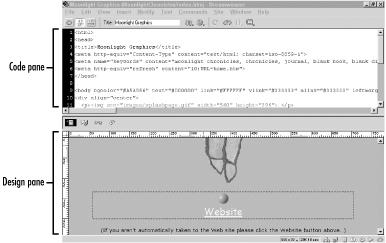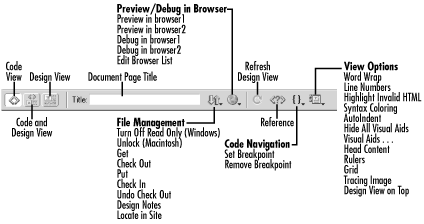Dreamweaver’s rich feature set makes it an indispensable tool for professional web developers. Its visual interface offers easy access to standard HTML objects such as tables and frames, plus prebuilt scripts and behaviors, timeline-based activities, CSS support, and a JavaScript debugger. For webmasters, Dreamweaver includes site-management tools such as File Check In/Check Out and Design Notes.
This book covers Dreamweaver’s practical usage, including its site management features. Reference material from O’Reilly & Associates covering HTML, Cascading Style Sheets (CSS), and JavaScript is also included within the Dreamweaver 4 (DW4) Reference panel (Window → Reference).
This chapter will familiarize you with Dreamweaver’s Document window and some common elements you’ll use within it. These topics will help orient those who are familiar with HTML or earlier versions of Dreamweaver, but may be new to Dreamweaver 4. Although you should plan your site before beginning serious production work, this chapter will help you perform quick edits on existing pages and get immediate hands-on experience. For those who prefer the “top-down” approach, refer to Part II, which covers site management.
Your use of Dreamweaver will rely heavily on the Dreamweaver user interface (UI) objects discussed in this chapter. Macromedia’s documentation variously refers to Dreamweaver’s UI components as panels , inspectors, editors, bars, windows, and palettes, and we follow those conventions when referring to them individually. For convenience, we use the term panels to refer to them collectively.
This chapter covers:
The Document window in its various views, plus its Toolbar and status bar
The Objects panel and its respective categories
The Property inspector and its selection of options
The Reference panel and its vast selection of HTML-, JavaScript-, and CSS-related information
The Launcher bar used to access other Dreamweaver panels, such as the Behaviors, CSS Styles, HTML Styles, and Timelines panels.
In later chapters, we’ll cover the interface options that control such things as tables, layers, frames, forms, markers, rulers, gridlines, and tracing images. With these options, Dreamweaver stands above other visual development tools.
Tip
Hidden contextual pop-up
menus
can be accessed
using
right-click on Windows or Ctrl-click on the
Macintosh. Use this shortcut when the book tells you to choose an
option from the contextual menu. These menus vary, depending on which
window or object you click.
Web pages are composed in the Dreamweaver Document
window
, which can be
viewed in several
modes:
Code view (View → Code) allows you to edit HTML source code directly.
Code and Design view (View → Code and Design), shown in Figure 1-1, shows the Code and Design panes simultaneously. Resize the two panes by dragging the horizontal line that separates them. Use the View → Design View on Top option to reverse the location of the panes.
You can switch view modes using the View → Switch Views command, Ctrl+Tab (Windows), or Opt+Tab (Macintosh). While in Code and Design view, the Switch Views command moves the cursor into the other pane; otherwise, it toggles between Code view and Design view.
Text can be typed directly into the Design pane. Dreamweaver automatically creates the necessary HTML when you insert objects using, say, the Objects panel. Edits performed in the Design pane are reflected immediately in the Code pane.
You can hand-edit the HTML code directly in the Code pane, but the visible results, if any, won’t appear in the Design pane until it is refreshed. The Design pane refreshes automatically when switching from Code view to Design view, but not when switching from Code view to Code and Design view.
Tip
After hand-editing HTML, use View → Refresh Design View, F5, Ctrl+Space (Windows), or Cmd+Space (Mac) to reevaluate the HTML in the Code pane and refresh the Design pane.
You can configure the following Code pane options under View → Code View Options:
- Word Wrap
Turn on this option to wrap long lines of HTML code (this option does not affect text in the Design pane).
- Line Numbers
- Highlight Invalid HTML
This option helps to avoid hand-coding errors by highlighting unsupported and unmatched tags in yellow. Reevaluate the HTML in the Code pane by using the shortcuts in the preceding tip. The Design pane always highlights errors.
- Syntax Coloring
This option highlights HTML tags and body text according to the settings under Edit → Preferences → Code Colors.
- Auto Indent
This option indents text automatically according to the settings under Edit → Preferences → Code Format.
While in Code view, some menu options that are ordinarily available
in Design view are inactive. You can use some menu options, such as
those under the Insert menu in Code view. Use caution, however,
because they’ll insert HTML wherever your cursor is, which may
put the HTML in an invalid place, such as outside the
<html> tags.
Code view is convenient for viewing and editing other types of non-HTML documents, such as JavaScript (.js ) files. Each document window has its own Code view, so you can use Code view for one page while using Design view for another page. The older Code Inspector, opened using Window → Code Inspector (F10), shows the code of the current page. The Code Inspector is a legacy from earlier versions of Dreamweaver and has been superceded by Code view.
The Document window has a convenient
Toolbar
with icons for commonly used operations. Use View → Toolbar,
Ctrl+Shift+T (Windows), or Cmd+Shift+T (Mac) to ensure that the
Toolbar is visible. The Toolbar, which changes according to the type
and contents of your document, lets you switch among
view modes and access other common
functions as indicated in Figure 1-2.
The status bar
at the bottom of the Document
window, as shown in Figure 1-3, contains the Tag
Selector, Window Size pop-up menu, and the Mini-launcher bar. It also
shows the current document’s size and estimated download time.
The status bar can be configured under Edit
→ Preferences → Status Bar or by clicking the
Edit Sizes option in the Window Size
selector as described in Chapter 18.
- Tag Selector
The
Tag Selectoris visible only in Design view or when the Design pane is active in Code and Design view. It displays the HTML tags that control the currently selected item. The tag of the exact selection is shown in bold, and you can change the selection by clicking the other tags that appear in the Tag Selector. See Section 7.1.5 in Chapter 7.- Window Size pop-up menu (Design view only)
The
Window Size pop-up menumakes it easy to preview your pages at various screen sizes. The usable screen area is usually less than the monitor resolution due to the toolbars and borders associated with typical browsers. Because HTML window sizes are fluid, this setting has no bearing on the window size when the document is viewed in the user’s browser. Use frames or JavaScript to control the size of the window in which your HTML page is displayed.- Document size and estimated download time
The document size shown in the Status bar is the size of the HTML page plus the size of any images or media files used in the document. The download time estimate is based on a 28.8 Kbps connection, but the target connection speed can be configured under Edit → Preferences → Status Bar. Most users have a 56 Kbps connection, but a more limited number have faster connections (ISDN, DSL, cable, satellite, and T1).
- Mini-launcher
The
Mini-launcheris a much more compact and convenient version of the Launcher bar, discussed later in this chapter.
Get Dreamweaver in a Nutshell now with the O’Reilly learning platform.
O’Reilly members experience books, live events, courses curated by job role, and more from O’Reilly and nearly 200 top publishers.




